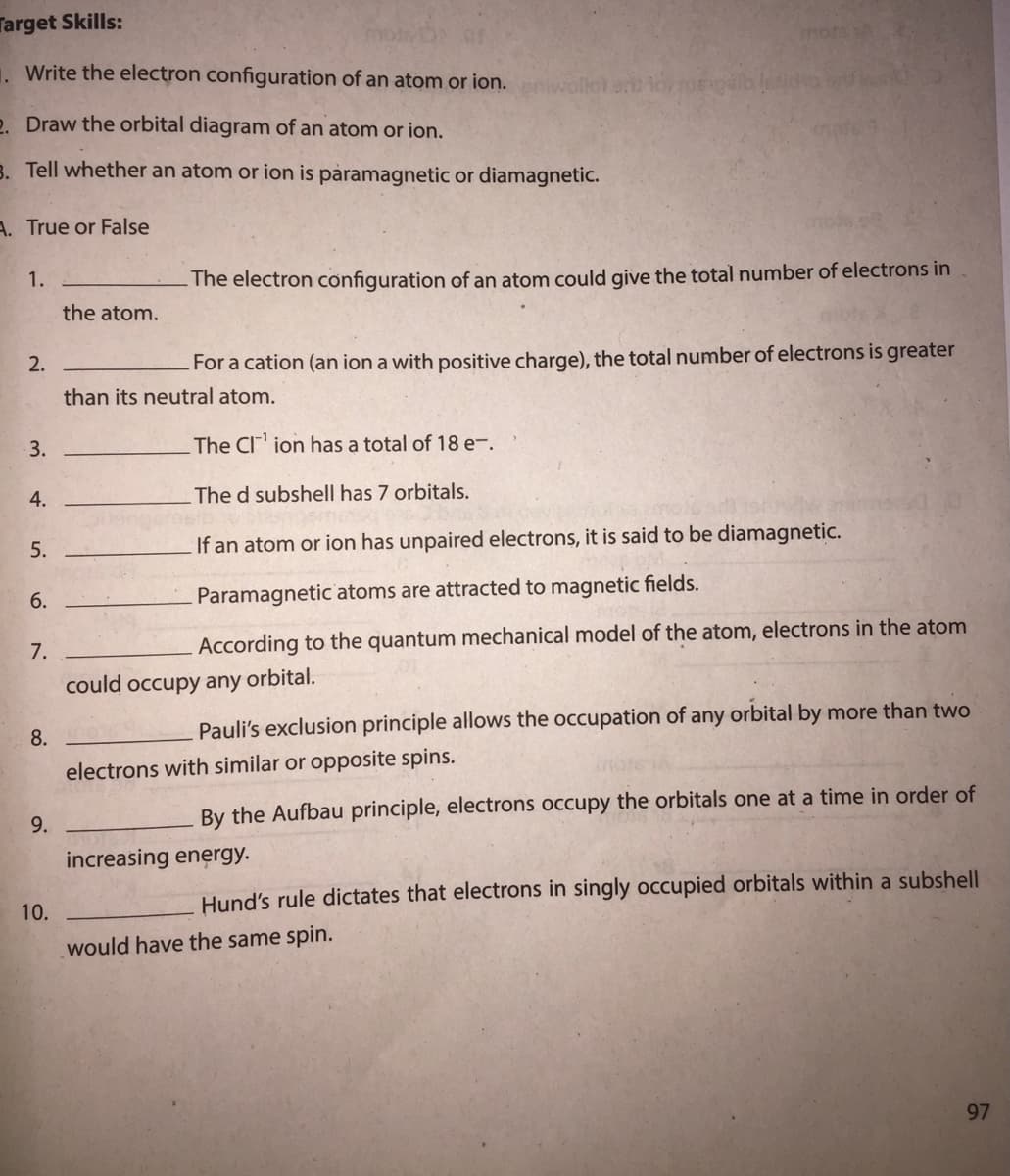Chemistry by OpenStax (2015-05-04)
1st Edition
ISBN:9781938168390
Author:Klaus Theopold, Richard H Langley, Paul Flowers, William R. Robinson, Mark Blaser
Publisher:Klaus Theopold, Richard H Langley, Paul Flowers, William R. Robinson, Mark Blaser
Chapter6: Electronic Structure And Periodic Properties Of Elements
Section: Chapter Questions
Problem 41E: Consider the orbitals shown here in outline. (a) What is the maximum number of electrons contained...
Related questions
Question
Please help me answer this.

Transcribed Image Text:Target Skills:
mots
. Write the electron configuration of an atom or ion. woflot a iorege
2. Draw the orbital diagram of an atom or ion.
3. Tell whether an atom or ion is pàramagnetic or diamagnetic.
A. True or False
1.
- The electron configuration of an atom could give the total number of electrons in
the atom.
2.
For a cation (an ion a with positive charge), the total number of electrons is greater
than its neutral atom.
3.
The CI ion has a total of 18 e-.
4.
The d subshell has 7 orbitals.
5.
If an atom or ion has unpaired electrons, it is said to be diamagnetic.
6.
Paramagnetic atoms are attracted to magnetic fields.
7.
According to the quantum mechanical model of the atom, electrons in the atom
could occupy any orbital.
Pauli's exclusion principle allows the occupation of any orbital by more than two
8.
electrons with similar or opposite spins.
By the Aufbau principle, electrons occupy the orbitals one at a time in order of
9.
increasing energy.
Hund's rule dictates that electrons in singly occupied orbitals within a subshell
10.
would have the same spin.
97
Expert Solution
This question has been solved!
Explore an expertly crafted, step-by-step solution for a thorough understanding of key concepts.
Step by step
Solved in 2 steps

Knowledge Booster
Learn more about
Need a deep-dive on the concept behind this application? Look no further. Learn more about this topic, chemistry and related others by exploring similar questions and additional content below.Recommended textbooks for you

Chemistry by OpenStax (2015-05-04)
Chemistry
ISBN:
9781938168390
Author:
Klaus Theopold, Richard H Langley, Paul Flowers, William R. Robinson, Mark Blaser
Publisher:
OpenStax

Introductory Chemistry: A Foundation
Chemistry
ISBN:
9781337399425
Author:
Steven S. Zumdahl, Donald J. DeCoste
Publisher:
Cengage Learning

Living By Chemistry: First Edition Textbook
Chemistry
ISBN:
9781559539418
Author:
Angelica Stacy
Publisher:
MAC HIGHER

Chemistry by OpenStax (2015-05-04)
Chemistry
ISBN:
9781938168390
Author:
Klaus Theopold, Richard H Langley, Paul Flowers, William R. Robinson, Mark Blaser
Publisher:
OpenStax

Introductory Chemistry: A Foundation
Chemistry
ISBN:
9781337399425
Author:
Steven S. Zumdahl, Donald J. DeCoste
Publisher:
Cengage Learning

Living By Chemistry: First Edition Textbook
Chemistry
ISBN:
9781559539418
Author:
Angelica Stacy
Publisher:
MAC HIGHER

Chemistry: Principles and Reactions
Chemistry
ISBN:
9781305079373
Author:
William L. Masterton, Cecile N. Hurley
Publisher:
Cengage Learning

Chemistry: Matter and Change
Chemistry
ISBN:
9780078746376
Author:
Dinah Zike, Laurel Dingrando, Nicholas Hainen, Cheryl Wistrom
Publisher:
Glencoe/McGraw-Hill School Pub Co

World of Chemistry, 3rd edition
Chemistry
ISBN:
9781133109655
Author:
Steven S. Zumdahl, Susan L. Zumdahl, Donald J. DeCoste
Publisher:
Brooks / Cole / Cengage Learning